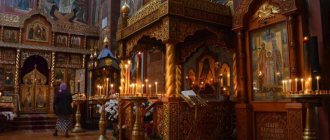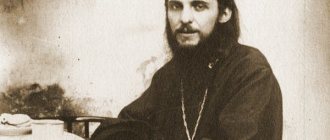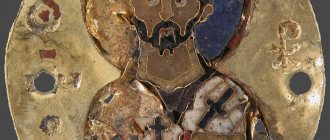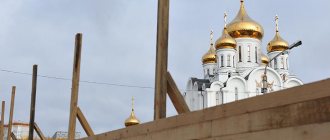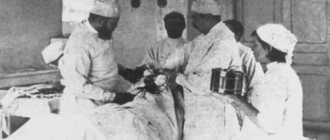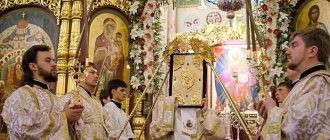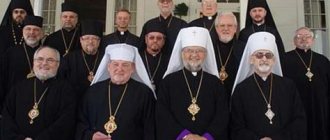| Ep. John (Pommer) |
John (Pommer)
(1876 - 1934), Archbishop of Riga and Mitau, Hieromartyr Commemorated on September 29 on the day of his death, in the Cathedral of New Martyrs and Confessors of Russia, in the Cathedrals of Belarusian and Galician Saints
In the world, Ivan Andreevich Pommer, was born on January 6, 1876 in the Ilzessala farmstead of Prauliensky volost in the family of a pious Orthodox Latvian peasant. His parents were simple, devout and pious Christians, and his great-grandfather was one of the first Latvians to convert to the Orthodox faith. Constantly helping his parents in hard peasant labor, the youth John grew up strong and physically resilient. At the same time, he was distinguished by his thoughtfulness, thirst for knowledge of the Word of God, and had a dreamy nature. He studied diligently and behaved exemplarily. In August 1887, he enrolled in the Riga Theological School, after graduating from which, in 1891 he entered the Riga Theological Seminary. Even then, John was distinguished by his firmness in faith. In June 1897, he graduated from the full course of the seminary with a 1st degree diploma.
In 1897-1899 he was a teacher at the Laudon parish school, and from 1899 to 1900 - in Libau (now Liepaja).
Then, from 1900 to 1904, he studied at the Kyiv Theological Academy, from which he graduated with honors and a candidate of theology degree. Here, in 1903, he accepted monasticism on the advice of Righteous John of Kronstadt, on September 23, 1903, he was ordained to the rank of hierodeacon, and on July 13, 1904, to the rank of hieromonk. While studying at the academy, he led the singing of the academic choir.
Teacher
Since 1904 - teacher of the Holy Scriptures at the Chernigov Theological Seminary. He quickly became known as a talented teacher.
Since 1906 - inspector of the Vologda Theological Seminary. Having shown a strong character, he participated in the successful restoration of order in this seminary during the period of revolutionary unrest, which contributed to his rapid promotion.
On September 26, 1907, he was elevated to the rank of archimandrite by the Archbishop of Vologda, and was soon appointed rector of the Lithuanian Theological Seminary and rector of the Vilna Holy Trinity Monastery. Thanks to the tireless care and dedicated work of Archimandrite John, the seminary was transformed beyond recognition.
Suffragan Bishop
On March 11, 1912, he was consecrated Bishop of Slutsk, vicar of the Minsk diocese. The consecration in the Alexander Nevsky Lavra was led by Metropolitan Vladimir (Epiphany) of Moscow and Metropolitan Flavian (Gorodetsky) of Kiev.
In 1912 he served as bishop in Odessa.
On April 4, 1913, he was appointed to the newly opened vicar see of the Ekaterinoslav diocese, with the title of Bishop of Taganrog and Azov. Already at this pulpit, the bishop was subjected to false accusations and imprisonment. When the bishop was imprisoned, a mass of people approached the prison in procession and demanded the release of their saint. Unable to resist the people, the persecutors released Bishop John from prison and, accompanied by his faithful flock, singing prayers, the archpastor went to the cathedral to serve a thanksgiving prayer service.
On September 7 (20), 1917, he was appointed Bishop of Staritsky, vicar of the Tver diocese.
Penza bishop
On April 22, 1918 - Bishop of Penza and Saransk, and was later elevated to the rank of archbishop.
Here he had to fight the “people's Church” organized in Penza by defrocked Archbishop Vladimir (Putyata) - one of the first non-canonical church groups of the renovationist type, which, with the support of the Bolsheviks, was destroying diocesan life. Heretical schismatics captured the Penza Cathedral and the main churches.
Archbishop John arrived at his new place of ministry in Penza on Tuesday of Holy Week 1918. The believers greeted him with love and surrounded him with signs of the most touching attention, settling him in a country monastery to avoid a sudden attack. The Living Church members were going to seize the Peter and Paul Church of the city on Maundy Thursday, but Bishop John, with an inspired sermon, converted those who were hesitant to follow Christ and the true Church. Already the first services attracted the hearts of many believers to him.
From the very beginning, the Bolshevik government treated the new archpastor with extreme hostility. They carried out a thorough search of the bishop's house, conducted an interrogation, but did not even find a reason for persecution. The schismatic false bishop and the security officers supporting him, seeing their complete defeat, decided to kill Archbishop John. On the evening of Thursday of Bright Week, two security officers entered the monastery, broke the doors and one of the attackers shot point-blank at the archbishop standing in the middle of the cell. But the monk, hiding on the side of the door, hit the shooter in the hand and the bullet hit the bishop in the leg, causing only a small wound, while the other monks sounded the alarm. The workers who had come running to the alarm gathered in the cell and wanted to commit lynching on the spot against those who had attempted to do so, and only the decisive intervention of the bishop saved their lives.
The Bolsheviks did not abandon their intentions to deal with the archpastor. In May 1918, they opened artillery fire on the Transfiguration Monastery, where the archbishop was staying, and several shells hit the cells adjacent to the cell of Bishop John, without causing him any harm. In September 1918, a thorough search was carried out in the cell and office of Archbishop John, which did not yield any results, and the bishop himself was taken to the Gubchek for a confrontation. Memorial services for the “newly deceased” Archbishop John had already begun to be held in churches, but this time the Bolsheviks released him.
On the feast of the Beheading of John the Baptist, schismatics attempted to seize the Peter and Paul Church, but the Bishop inspired the people to defend the temple. Then Archbishop John was arrested by the Cheka, he was imprisoned and prepared for execution. But the people of God demanded the release of the archpastor and at the last deadline, at about one in the morning on the day of the scheduled execution, it was announced to him that he was free.
During the imprisonment of the holy confessor, the godless authorities abolished all bodies of diocesan administration, but soon the bishop managed to achieve the restoration of the diocesan council and other bodies.
On July 28, 1919, Archbishop John was summoned to the military commissariat, where he was subjected to a recruiting examination and declared fit for military service, enlisting in the rear militia. At the request of the parishes of the diocese, the appearance in the militia was temporarily postponed. Visiting the parishes of the diocese was impossible without special permission from the persecutors. The White Army was approaching Penza and the persecution of the Church intensified, the most prominent church ministers were arrested.
At this time, at the invitation of the parishes, the archbishop went on a long trip around the diocese. The people joyfully greeted their archpastor. The services were held with great spiritual enthusiasm and in the presence of huge masses of people. Upon returning to Penza, in October 1919, the ruler was arrested again, slandered for his participation in a counter-revolutionary organization invented by the security officers.
At that time, those arrested were subjected to severe torture; some could not stand the torture and slandered not only themselves, but also other innocents. Thus the bishop’s subdeacon was slandered and shot. The same fate was prepared for the saint. But the bishop demanded a review of the case in Moscow. Transferred to a Moscow prison, he was placed in the same cell with criminals. One of the witnesses to his imprisonment said that one night a frostbitten and intoxicated criminal was brought to a prison cell. Seeing the archbishop, he began to mock cynically, but was stopped by his comrades, who told him that it was the Archbishop of Penza. The Bishop, full of Christian mercy towards the new inhabitant of the cell, warmed him, fed him and looked after him. The Christian attitude awakened good feelings in the fallen man, and he became the saint’s helper. Together they carried typhoid patients on stretchers, cared for those lying unconscious, performing a feat of Christian charity at the risk of their own lives.
In Moscow, the chairman of the secret operational department of the Cheka himself took up the archbishop’s case. The persecutors collected all the slander that had ever been leveled against the bishop, but were unable to prove his guilt, and in March 1920, Archbishop John was acquitted.
Archbishop of Riga
Thus, Bishop John healed the schism in the Penza diocese, and the Patriarch appointed him Archbishop of Riga and Mitau. Penza clergy and laity did not want to let him go, but in view of the persistent requests of the Latvian flock, Saint Tikhon gave final consent to Archbishop John’s departure to Latvia, honoring him with a letter of gratitude for his selfless and fruitful work in various places of ministry in Russia.
In 1921, Bishop John took over the administration of the diocese and, at his request, the Latvian Church received broad autonomy while remaining part of the Russian Church: this decision was approved on June 21, 1921 by Patriarch Tikhon, the Synod and the Supreme Church Council.
Bishop John enjoyed great authority among Orthodox believers - both Latvians and Russians. In 1923, at the Council of the Orthodox Church in Latvia, its charter was adopted, providing all members of the church, without distinction of nationalities, with the rights provided for by the canons.
In 1926-1931, the bishop was a deputy of the Latvian Seimas, in which he actively defended the interests of the Orthodox Church and often came into conflict with representatives of left-wing parties. In 1926, he achieved the adoption of a law on the legal status of the Orthodox Church in Latvia, which stated that it had the right to “freely and openly implement” Orthodox doctrine. The Church and its institutions owned the rights of legal entities, the property rights of the Church were guaranteed, the creation of religious schools, the establishment of Orthodox societies and unions was allowed, and the decisions of the spiritual authorities in canonical matters were not subject to appeal in secular institutions. In pursuance of this law, on December 1, 1926, the Riga Theological Seminary was reopened. In addition, the bishop resolutely spoke out in defense of the interests of the Russian population of Latvia. With his participation, laws were adopted regulating the opening of Russian educational institutions, the main Russian schools and gymnasiums began to receive benefits from the cultural fund. The number of Russian educational institutions increased, public libraries were opened, and the situation in preschool education was improved.
Martyrdom
| Archbishop John (Pommer) |
The archbishop's health was undermined by backbreaking labor and difficult living conditions.
Suffering from physical ailments, he was forced to move to the bishop's dacha near Kishozero. Here Archbishop John was killed on the night of October 12, 1934. The Archbishop was tied to a door taken off its hinges and subjected to terrible torture on a workbench. Everything indicated that the saint’s legs were burned with fire, he was shot from a revolver and was set on fire alive. There were three main versions of the reasons for the death of the ruler. According to the first, adopted in Soviet times, he was killed by supporters of the Latvian leader Karlis Ulmanis because he advocated maintaining canonical ties with the Moscow Patriarchate, since after the death of Bishop John the Latvian Church came under the omophorion of the Patriarchate of Constantinople. However, there is no objective evidence for this version - in Latvian politics, Bishop John was more of an ally of the government in the fight against leftist forces.
The second version is related to conflicts within the Latvian Church, including disagreements between Bishop John and the public organization Russian Student Christian Movement. During the investigation into the murder of the archbishop, some members of this organization were arrested, and the activities of the movement itself in Latvia were prohibited. However, this version was not confirmed either.
The most common version connects the murder of Archbishop John with the activities of Soviet agents. Attention is drawn to the secret connections of the head of the Latvian Church with Orthodox believers in the USSR, from whom he received information about the persecution of religion - this could cause discontent among representatives of the Soviet government. In addition, as a politician in Latvia and a member of the Seimas, Archbishop John was a consistent anti-communist and critic of pro-Soviet forces in his country. There is an assumption that on the evening of October 11, the bishop was visited by the famous singer Leonid Sobinov, who had arrived in Riga, and the killers could have broken into the house when the archbishop opened the door for him. Sobinov himself soon died suddenly in a hotel room in Riga, and the Soviet embassy forbade performing an autopsy on the deceased, and the cause of death was declared to be a broken heart. The body of the deceased was quickly transported from the hotel to the embassy building, and then sent to Moscow by funeral train. However, this version is also based on assumptions and indirect evidence.
Poor little Janis
As a child, Janis tended sheep.
And the memories of how he prayed with his family remained in Vladyka’s memory for the rest of his life. This is how their every day began: everyone gathered in one room, the father read a chapter from the New Testament, then the children read aloud and sang prayers. Janis was distinguished by good health and endurance. He often liked to dream about something, think about it, and look at something. He turned out to be capable of learning, and at the age of 9, a boy from a poor family who had not attended primary school was immediately enrolled in school. The teachers took notice of him, and the priest recommended the seminary.
Man of iron will
Riga Theological Seminary, 1920s.
Photo from the site srcc.msu.ru At the age of 24, a graduate of the Riga Theological Seminary, John Pommer, was accepted into the Kiev Theological Academy. It was there that the decision to become a monk came. In order to be sure, John asked the righteous John of Kronstadt for advice, and he gave his blessing.
From 1907 to 1912, Archimandrite John was the rector of the Holy Trinity Monastery, as well as the rector of the Vilna Theological Seminary. They speak of him as a man of iron will, brilliant organizational skills, who can raise any cause. Soon the arch. John is consecrated bishop.
Revenge of the nationalists
According to the second version of the murder, accepted during the Soviet era, responsibility for it lies with the Latvian leader Kārlis Ulmanis .
Karlis Augusts Vilhelms Ulmanis. Latvian politician and statesman. Authoritarian ruler of Latvia in 1934-1940.
On May 15, 1934, he carried out a military coup, liquidated all political parties, closed many newspapers, suspended the activities of the Sejm, and declared a state of emergency. Ulmanis's dictatorship had a pronounced nationalistic character, the rights of the Russian population were infringed, and many Russians were dismissed from government bodies.
Let us recall that Bishop John actively defended the rights of the Orthodox Church and the Russian minority (for example, thanks to him, Russians entered the government of Latvia). Despite the sharp condemnation of the Soviet regime, it maintained the canonical connection of the Latvian Church with the Moscow Patriarchate even after the Declaration of Loyalty to the Soviet Power by Metropolitan Sergius in 1927. Of course, such a church position could be perceived with caution by the authorities. Moreover, in Poland, Finland and Estonia - other parts of the former Russian Empire - the canonical unity with the Moscow Patriarchate was broken, and Orthodox communities began to submit to the Patriarchate of Constantinople. After the death of Archbishop John, the Latvian Church also found itself under the omophorion of Constantinople.
Funeral of John Pommer. Riga
“Ilyich is very unlike Christ”
Photo: vk.com
Since 1917, Saint John served in the Tver diocese, where before him renovationists tried to seize churches. Saint John speaks of them like this: “They inserted Marx into the binding of the Gospel and think that the people will accept him instead of the Gospel. They dressed the commissars in sacred vestments and think that the Orthodox will accept them as their shepherds and follow them. They replaced the image of Christ in the icon cases with a portrait of Lenin and are waiting for the people to “attach”.
Ilyich is very different from Christ. Christianity cannot be replaced by Marxism, no matter what robes you dress the preachers of Marxism in. Here is love incarnate, shedding its blood for guilty brothers, there is satanic malice, shedding the blood of innocent brothers like water.”
Orthodoxy in Latvia
Photo from the site pravoslavie.ru
During the revolutionary years, the Latvian Orthodox Church experienced persecution from the Soviet regime. During the First World War and the revolution, the Riga Theological Seminary was closed. When Latvia became independent, the national Latvian authorities did not want the Orthodox Church to remain a diocese of the Russian Orthodox Church. There was no ruling bishop at the episcopal see.
Orthodox churches in Latvia were robbed, iconostases were destroyed everywhere, crucifixes were thrown into the trash... Even the tin covering church domes was torn off for repair work of government institutions. They planned to make a tomb of national heroes in the Riga Cathedral or simply blow it up.
Then the Orthodox of Latvia began to ask Patriarch Tikhon to send “one of his own” to them - Bishop John (Pommer).
The Patriarch listened to their opinion and sent Bishop John to Latvia, giving the Latvian Orthodox Church the broadest rights of autonomy.
The new primate of the Latvian Church had, on the one hand, to literally fight off more than once the Latvian authorities, who did not disdain to attack the bishop, and, on the other hand, to remove the persistent proposals of the Patriarchate of Constantinople, and later the Karlovac Synod, to “secede” from the Russian Orthodox Church.
Archbishop John in the Latvian Seimas. Photo from the website srcc.msu.ru
To strengthen his position as a citizen, the smart Bishop John decides to become a deputy of the Latvian Seimas and becomes one, despite the hostile environment.
And the Orthodox Church in Latvia acquires the status of a “legal entity”, allowing it to be protected by law.
But in his pastoral activities, Archbishop John (Pommer) never divided the people into Russians and non-Russians, Orthodox and non-Orthodox. The poorest and most unfortunate people of all faiths and nationalities called him their protector and patron.
Home › Shrines › Saints
Hieromartyr John (Pommer), Archbishop of Riga
Hieromartyr John of Riga, in the world Janis (Ivan Andreevich) Pommer, was born on January 6, 1876 in the Livonia province (Latvia) into a Latvian Orthodox peasant family. Orthodoxy entered the life of the Pommer family even under their great-grandfather, despite strong resistance and cruel persecution from German landowners. Every day and every period of work in this family began with prayer. The whole family gathered together, the father read a chapter from the New Testament, the children sang and read prayers. And, in general, this family loved to sing church hymns. The seasons were counted not by months, but by church holidays.
In August 1887, John Pommer was enrolled in the Riga Theological School, graduating from which in 1891, he entered the seminary.
In 1897, John graduated from the Riga Theological Seminary with a first-degree diploma, and in 1904 from the Kyiv Theological Academy with honors and a candidate of theology degree.
During his years of study at the academy, his determination to devote his entire life to serving the Church of Christ strengthened. The future ascetic was blessed on the path of monastic life by the great prayer book and wonderworker of the Russian land, St. Righteous John of Kronstadt. In 1903, John took monastic vows, was ordained a hierodeacon on September 23, and a hieromonk on July 13, 1904.
Since 1904 he was a teacher of Holy Scripture at the Chernigov Theological Seminary, and since 1906 - an inspector at the Vologda Theological Seminary. On September 26, 1907, Father John was elevated to the rank of archimandrite.
Since 1907, he was the rector of the Riga Theological Seminary and the rector of the Vilna Holy Trinity Monastery.
Thanks to the tireless care and dedicated work of Archimandrite John, the Vilna Theological Seminary has changed beyond recognition. The singing of the seminary choir has reached a very high level. The rector paid great attention to reading during services, teaching students to do it reverently, with a sense of great responsibility. Being an excellent preacher, Archimandrite John made a lot of effort to put the art of preaching at the highest level, personally listened to the sermons of his students, gave instructions and explanations.
In 1912 he was consecrated Bishop of Slutsk, vicar of the Minsk diocese; since 1913 - Bishop of Taganrog, vicar of the Ekaterinoslav diocese; since 1916 - Bishop of Azov and Taganrog; from September 1917 - Bishop of Staritsky, vicar of the Tver diocese.
On April 22, 1918, the Right Reverend John was appointed Bishop of Penza and Saransk, as a hierarch who, according to Patriarch Tikhon, was able to cope with the “Putyatin Troubles” that flared up in the diocese - a church schism caused by the former Archbishop of Penza Vladimir (Putyata). Bishop John played an exceptional role in overcoming the schism and strengthening the diocese under the new atheistic government.
Already the first bishop's services attracted the hearts of the people of God to the ruler. The Bolshevik government treated the new archpastor with extreme hostility.
On the evening of Thursday of Bright Week, two security officers entered the monastery, approached the Bishop’s cell and knocked. They didn’t open the door, and then they started breaking down the doors. At this time, the monks came running and sounded the alarm. The door was broken open, and one of the attackers shot point-blank at Archbishop John, who was standing in the middle of the cell. But the Lord preserved His chosen one: the monk, hiding on the side of the door, hit the shooter in the hand. The bullet hit Vladyka John in the leg, causing a small wound.
At that moment, workers who had come running to the sound of the alarm appeared in the cell. The failed killers were dragged out of the room and began to be beaten. Vladyka John protected them.
But the Bolsheviks did not abandon their intentions to deal with the archpastor. In May 1918, they opened artillery fire on the Transfiguration Monastery, where the saint was staying. Several shells hit the cells adjacent to the cell of Vladika John, without causing him any harm.
In September 1918, a thorough search was carried out in the cell and office of Archbishop John, which did not yield any results, and the bishop himself was taken to the Gubernia Cheka for a confrontation. It was evening. All-night vigils began to be served in churches. When the believers learned that the saint had been taken to “a house from which they do not return,” people decided that the bishop had been shot along with other prisoners. By the ineffable mercy of God, having returned to the temple, the bishop heard a memorial service being performed for the “newly deceased” Archbishop John.
Penza prison
On the day of commemoration of the Beheading of John the Baptist, an attempt was made again to seize the Peter and Paul Church. But the holy archbishop was calm and not only encouraged the parishioners, but also encouraged those praying to protect the temple. The trials didn't end there. Archbishop John was arrested and imprisoned.
On the day of execution of death sentences in prison, prisoners were called one by one according to the list in which Archbishop John was listed last. The prisoners left their cells and never returned. The sentences were carried out immediately. The archbishop experienced everything that those sentenced to death go through, and it was only around one in the morning that it was announced that he was free.
During the imprisonment of the holy confessor, all diocesan government bodies were abolished. Vladyka John had to take upon himself all matters related to the administration of the huge diocese.
The civil war was in full swing, the White Army was approaching Penza. The persecution of the Church intensified. At that time, the archbishop went on a long trip around the diocese. The people joyfully greeted their archpastor. The services were held with great spiritual enthusiasm, with huge crowds of people coming together. Upon returning to Penza, Vladyka John was arrested again, accused of participating in a counter-revolutionary organization invented by the security officers, but in March 1920, Archbishop John was acquitted.
Serving at the Penza See was a continuous feat of confession. In fact, it was thanks to the Right Reverend John that the Penza Church was preserved during these years; in a short period of time he raised a whole galaxy of zealous clergy, many of whom in subsequent years accepted suffering and death for Christ, among them three were glorified as saints: the holy martyrs Augustine of Kaluga, Nikolai Prozorov and the holy confessor John Kalinin.
By Easter 1920, Bishop John was elevated to the rank of archbishop.
By 1921, with his confessional example, vivid preaching and earnest service, Bishop John healed the schism in the Penza land. And Patriarch Tikhon decided to appoint him Archbishop of Riga. But Penza clergy and laity did not want to let go of their beloved Bishop. And only because of the persistent requests of the Latvian flock, His Holiness Patriarch Tikhon gave final consent to the departure of Archbishop John to Latvia, honoring him with a letter of gratitude for his selfless service.
Since July 1921, Hieromartyr John has been Archbishop of Riga and All Latvia. The state of the Orthodox Church of Latvia at that time of troubles was sad. Not recognized by the state, it was given over for plunder. The flock was scattered, and Orthodoxy was persecuted. During the years of the First World War and the revolution in Latvia, Orthodox theological education was destroyed, and the Riga Theological Seminary was taken away. The Riga See was widowed: there was no archpastor. The entire subsequent life and ascetic labors of the saint, as an archbishop and deputy of the Sejm, were aimed at serving the Church, his Motherland and the common people. He cared equally about Russians, Latvians, and people of other nationalities. For him there were no friends or strangers, everyone was brothers.
The protector and patron of the disadvantaged, the Vladyka himself lived more than modestly. The dark and damp room that became his home in the basement of the cathedral with a barred window near the ceiling, through which all the sounds of the central boulevard penetrated, was in an extremely neglected state. The smoky walls were covered with stains of mold and dampness.
Living in the basement, Archbishop John received distinguished guests there. One of the foreign visitors with tears in his eyes exclaimed: “Believe me, in my fatherland not a single prisoner lives in such a hole as you, head of the Latvian Orthodox Church!” The furnishings in Vladika John's cell were very simple: a few armchairs, chairs, cabinets with books, icons. Above the table is a large portrait of His Holiness Patriarch Tikhon.
Vladyka John never distinguished people by social origin - he saw the image of God in everyone. Often the bishop was visited by criminals who had just been released from prison. The archpastor helped them, the repentants, to start a new life. Everyone felt the joy of communicating with the saint.
Vladyka John managed to eliminate ethnic strife not only in the Church: the unity of the Church contributed to the unity of secular society. Through the labors of the Bishop, Orthodox Russians, Latvians, Ukrainians, Belarusians, Estonians, Germans and people of other nationalities lived in complete unanimity and love with their archpastor and among themselves.
Trusting in the Lord, the saint knew no fear, courageously performing his confessional service. His Holiness Patriarch Tikhon called him “a man of struggle,” and the common people called him “the new Chrysostom.” Almost the entire Orthodox Riga gathered to listen to Archbishop John’s sermons.
The holy archbishop fully experienced attacks and threats, hatred and slander, persecution and persecution. But all this did not deter him.
The establishment of the rights of the Latvian Orthodox Church in the state required a lot of effort and work. Thanks to the tireless selfless efforts of Archbishop John, it was possible to achieve registration of the Church as a full-fledged legal entity.
On October 12, 1934, Archbishop John was brutally murdered by unknown assailants at his country dacha. On July 17, 2001, by decision of the Holy Synod of the Russian Orthodox Church, his name was included in the Council of New Martyrs and Confessors of the Russian Church.
In 2006, a part of his relics was transferred to the Penza diocese, which marked the beginning of widespread veneration of the saint in Penza. In October 2015, Metropolitan Seraphim of Penza and Nizhnelomov laid the foundation stone for the world’s first church in honor of John of Riga in Penza. On these same days, the Penza Theological Seminary hosted for the first time an International Scientific and Practical Conference dedicated to the memory of John of Riga and all the new martyrs and confessors of the Russian Church, which became an annual conference. On February 26, 2021, Forgiveness Sunday, for the first time in the new church in honor of the Hieromartyr John, a liturgy was celebrated by the bishop's rite. Since then, services have been held regularly in this temple.
In June 2021, the centenary of the appointment of the Right Reverend John to the Penza See was widely celebrated in Penza; his selected works and a book dedicated to the saint’s stay in Penza were published on this date.
In August and October 2021, the first part of the documentary film “Hieromartyr John of Riga” was filmed in the Penza region. On a passionate path."
Details about the Penza period of the ministry of the Hieromartyr John are also set out in the article “A Man of Struggle.”
Memory September 29 / October 12.
— Shortened link: https://eparkhiya.ru/?p=1504
Prisoners don’t live in such a pit!..
Riga.
Cathedral. Image from the website srcc.msu.ru Bishop John lived for a long time in a small room in the basement of the Cathedral. It had a small window in the ceiling, overlooking the central boulevard, which was very noisy. The walls were smoked and covered with stains of dampness and mold.
Here, in a moldy closet, distinguished foreign guests came to visit the Bishop: Estonian, Finnish and English bishops. One of them even burst into tears, exclaiming: “Believe me, in my Fatherland not a single prisoner lives in such a hole as you, head of the Latvian Orthodox Church!..”
The Lord called this room “his cave.” And when people began to sympathize with him, he laughed it off. And he continued to live in his cave - as a sign of protest against the transfer of the former bishop's residence to Catholics.
Honor and glorification[ | ]
In 2021, the Latvian Post issued a stamp with the image of John Pommer, author Lilia Dinere
In preparation for the canonization of new martyrs and confessors performed by the ROCOR in 1981, his name was included in the draft list of named new martyrs and confessors of Russia. The list of names of new martyrs and confessors of the ROCOR, which included the name of Archbishop John, was published only in the late 1990s[7].
The chapel at the Intercession Cemetery, where his remains were buried under cover, was a place of pilgrimage for Orthodox Christians; Archbishop John was canonized by the Serbian Orthodox Church[8].
On July 17, 2001, by the decision of the Holy Synod, the Russian Orthodox Church was glorified for church-wide veneration at the Council of New Martyrs and Confessors of the Russian Church.
On September 24 of the same year in Riga, at the next Council of the Latvian Orthodox Church, a decision was made on the canonization of the Hieromartyr John[8]. On October 25, the liturgy and rite of canonization were performed at the Nativity Cathedral in Riga[8].
On October 4, 2003, the recently discovered relics were transferred from the Intercession Cemetery Church (Meness Street, 3) to the Cathedral of the Nativity of Christ[8][9].
On May 27, 2006, by decrees of Metropolitan Alexander of Riga, the Order and Medal of the Hieromartyr John of Riga was established[10][11][12].
Miracles through the prayers of a “brilliant administrator”
Image of the Hieromartyr John.
Photo from the website pravoslavie.ru Since the time of Bishop John’s ministry in Latvia, things in the Church began to improve. Through the efforts of the bishop, the Riga Theological Seminary was restored, pensions began to be paid to the clergy, the state allocated subsidies for the restoration of destroyed churches, Russian schools, libraries, and higher Russian educational institutions began to have equal rights with other educational institutions.
In 1923, Bishop Pommer initiated the adoption of the Charter of the Orthodox Church in Latvia at the First Council of the Russian Orthodox Church. The document served to streamline church life in the country administratively and politically.
Essays
- “Memoirs of Archbishop John (Pommer)”:
- Almanac “Russian World and Latvia” No. 14: From the archives of St. Hieromartyr Archbishop of Riga and Latvia John (Pommer). Letters and other documents. Volume 1. Publication prepared by Sidyakov Yu.L., Riga 2008:
- Almanac “Russian World and Latvia” No. 20: From the archives of St. Hieromartyr Archbishop of Riga and Latvia John (Pommer). Letters and other documents. Volume 2. Publication prepared by Sidyakov Yu.L., Riga 2009:
- Almanac “Russian World and Latvia” No. 24: From the archives of St. Hieromartyr Archbishop of Riga and Latvia John (Pommer). Letters and other documents. Volume 3. Publication prepared by Sidyakov Yu.L., Riga 2011:
- Almanac “Russian World and Latvia” No. 37: From the archive of Hieromartyr John (Pommer). Letters and other documents. Volume IV (additional). Sidyakov Yu.L., Riga 2014:
Dacha near Kishozero
Photo from the site russkije.lv
Physical activity, experiences and difficult living conditions affected the health of the Latvian Archbishop. Vladyka moved to live in a dacha in Ozolkalne near Kishozero. Refused all security. The saint loved to spend his free time alone and in prayer. At the dacha he took care of the garden, worked on a workbench - he had carpentry skills since childhood.
